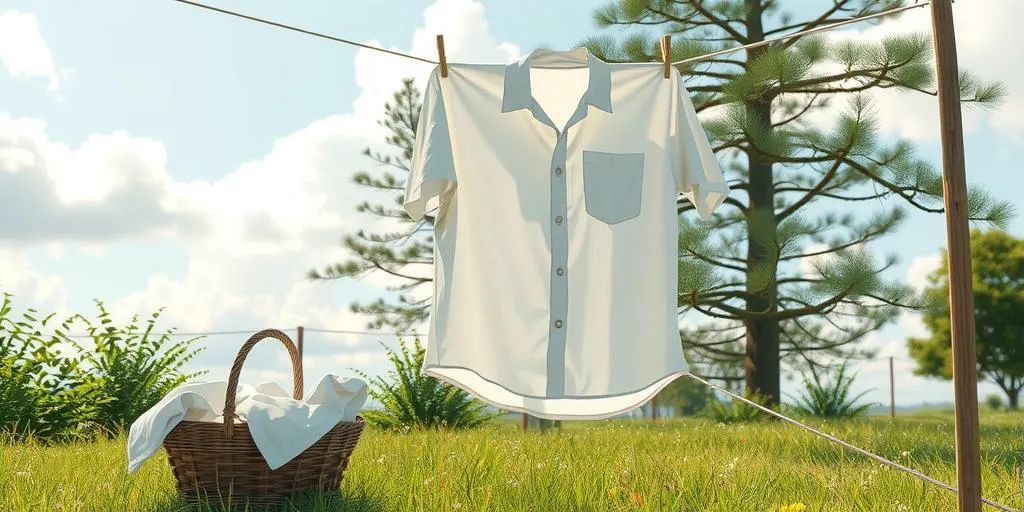
How to Care for Linen Shirts: A Simple Guide
Caring for linen shirts is straightforward and can help extend their lifespan. Start by washing them on a gentle cycle using cold or lukewarm water with a mild detergent, whether in a machine or by hand. Avoid hot water to prevent shrinkage. After washing, it's best to air dry the shirts in a shaded area; direct sunlight can fade their colors. If you need to iron, do it while the fabric is still damp and set your iron to medium-high heat, taking care not to use steam directly on the shirt. When storing, fold neatly or hang on padded hangers and avoid plastic bags for better air circulation.
1. Washing Linen Shirts: Machine vs. Hand Wash

When it comes to washing linen shirts, you have the option of machine washing or hand washing. For machine washing, use a gentle cycle with cold or lukewarm water, ideally around 30°C (86°F). Hot water can shrink the fabric, so it's best to avoid it. If you prefer hand washing, fill a basin with cold water and gently agitate the shirt. Be careful not to wring it out, as this can cause damage to the fibers. Regardless of the method, always use a mild detergent to protect the delicate linen.
|
Wash Method |
Water Temperature |
Detergent Type |
Drying Method |
Recommended Ironing Settings |
|---|---|---|---|---|
|
Machine Wash |
Cold or lukewarm (30°C/86°F) |
Mild detergent |
Air dry in shaded area |
Medium to high heat, slightly damp |
|
Hand Wash |
Cold water |
Mild detergent |
Air dry in shaded area |
Medium to high heat, slightly damp |
2. Best Drying Methods for Linen Shirts
To keep your linen shirts looking their best, the drying method you choose is crucial. The ideal way to dry linen is to hang it up in a shaded area. This allows the fabric to air dry naturally, helping to prevent fading and maintain its texture. Avoid exposing your linen shirts to direct sunlight, as this can cause colors to fade over time.
If you need to use a dryer, set it to the lowest heat setting available. However, air drying is still the preferred option for preserving the quality of linen. When hanging your shirt, make sure to use a sturdy hanger to prevent stretching. If you're short on space, laying the shirt flat on a clean, dry towel can also work well, allowing it to maintain its shape while drying. Always ensure that your linen shirt is completely dry before storing it to prevent mildew and musty odors.
3. Ironing Tips for Linen Care
Ironing linen shirts can seem daunting due to their tendency to wrinkle, but with the right techniques, you can achieve a crisp, polished look. First, it's best to iron your linen shirt while it's still damp. This helps the iron glide smoothly over the fabric and reduces the risk of scorching. If your shirt has dried completely, simply spritz it lightly with water to restore some moisture.
When it comes to heat settings, choose a medium to high temperature on your iron. Linen can withstand higher heat, but be cautious not to use steam directly on the fabric, as this can lead to unsightly water spots. Instead, if you prefer using steam, hold the iron a few inches above the fabric and let the steam do the work. For stubborn wrinkles, you can press down firmly with the iron for a few seconds.
To ensure the best results, start ironing the collar and cuffs before moving on to the body of the shirt, as these areas typically require more attention. For a neat finish, you can also iron the shirt inside out, which can help prevent any shine on the fabric. Lastly, always check the care label for any specific ironing instructions that may apply to your particular shirt.
4. How to Store Linen Shirts Properly
To keep your linen shirts looking fresh, proper storage is key. Start by deciding whether to fold or hang your shirts. If you choose to fold, do so neatly to avoid deep creases. Hanging is often preferred; use padded hangers to support the fabric without causing shoulder bumps. Avoid storing linen shirts in plastic bags, as they can trap moisture and lead to mildew. Instead, opt for breathable cotton or linen garment bags that allow air circulation, helping to prevent musty odors. If you have limited space, consider rolling your linen shirts instead of folding them, which can also reduce wrinkles.
5. Quick Guide to Handling Stains
To keep your linen shirts looking their best, it's crucial to tackle stains promptly. Start by acting quickly—blot the stain gently with a clean cloth or paper towel to absorb any excess liquid. Avoid rubbing, as this can spread the stain further.
For treating the stain, use a gentle stain remover or create a solution with mild detergent and water. Apply it directly to the stained area and let it sit for a few minutes. After treatment, rinse the fabric thoroughly with cold water to remove any residue. For tougher stains like red wine or grease, consider using a specialized stain remover, but always test it on a hidden area first to ensure it doesn't damage the fabric.
If you need to wash the shirt after stain treatment, follow the washing guidelines and avoid using hot water, as this can set the stain. By handling stains quickly and effectively, you can maintain the pristine appearance of your linen shirts.
-
Blot the stain immediately with a clean cloth.
-
Rinse the stained area with cold water from the back, if possible.
-
Apply a gentle stain remover or laundry detergent directly to the stain.
-
Avoid using hot water, as it can set the stain.
-
For oil or grease stains, sprinkle baking soda over the stain and let it sit before washing.
-
Test any stain removal method on a small, inconspicuous area first.
-
Wash the shirt according to the care label instructions after treating the stain.
6. Tips to Prevent Wrinkles in Linen
To keep your linen shirts looking fresh and wrinkle-free, start with pre-wash care. Adding a cup of vinegar to the rinse cycle can help relax the fibers and reduce wrinkles. When selecting linen shirts, consider the fit; looser styles tend to crease less than tightly fitted ones. After washing, avoid cramming linen shirts into your laundry basket or tightly folding them, as this can create deep creases. Instead, hang them up as soon as possible to allow gravity to help smooth out any wrinkles. When ironing, always work from the collar down to the hem, ensuring even pressure and heat distribution. Lastly, if you're traveling, roll your linen shirts rather than folding them, as this method minimizes creasing and helps maintain their shape.
7. General Care Tips for Linen Shirts
To keep your linen shirts looking their best, avoid using chlorine bleach, as it can damage the fibers and lead to discoloration. Instead, opt for oxygen-based bleach if needed. Rotating your linen shirts in your wardrobe is essential; this helps prevent wear and tear from repeated use. For instance, if you wear one linen shirt two days in a row, it may lose its shape and freshness faster than if you alternate with another. Additionally, be cautious with accessories. Heavy jewelry can snag the delicate fabric, leading to unsightly pulls or tears. Always check your accessories before wearing them with your favorite linen shirt to ensure they won't cause damage.
Frequently Asked Questions
1. What is the best way to wash linen shirts?
The best way to wash linen shirts is to use cold water on a gentle cycle. This helps preserve the fabric's quality and color.
2. How do I remove wrinkles from my linen shirt?
You can remove wrinkles from a linen shirt by ironing it on a medium setting while it's slightly damp. Alternatively, you can hang it up in a steamy bathroom.
3. Can linen shirts be dried in the dryer?
It's best to air dry linen shirts to avoid shrinking. If you must use a dryer, choose a low heat setting and remove the shirt while it's still slightly damp.
4. How do I store linen shirts to keep them in good shape?
Store linen shirts in a cool, dry place. You can hang them or fold them neatly to prevent creases.
5. Is it okay to bleach linen shirts?
No, it's not recommended to bleach linen shirts as it can damage the fibers. Instead, use a mild detergent for cleaning.
TL;DR To care for linen shirts, wash them in cold water using a gentle cycle or hand wash with mild detergent. For drying, air dry in a shaded area to prevent fading; avoid tumble drying. Iron while slightly damp on medium to high heat, and store by folding or hanging in a breathable bag. Handle stains promptly by blotting and using gentle stain remover. To prevent wrinkles, consider using vinegar in the rinse cycle and choose the right fit. Avoid bleach and rotate usage to extend the lifespan of your shirts.



